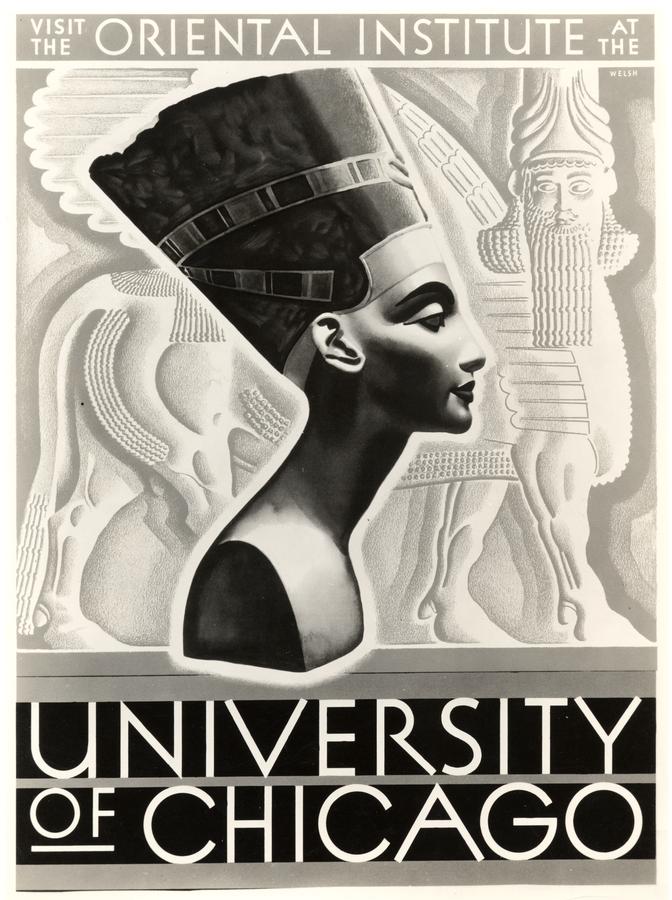"The cataloging of the Museum Archives has only just begun, but already users can search, sort, and display over 7,000 records and attached media (such as digitized photographs, negatives, and documents)."
Saturday, August 15, 2015
Oriental Institute Museum Archives Records Added to Online Collections
Tuesday, May 5, 2015
News: Technology reveals ancient Egypt’s complex history
Oriental Institute team uses digital tools to capture nuances and share research
By William Harms Photo Courtesy of Epigraphic Survey, Oriental Institute
May 4, 2015
By William Harms Photo Courtesy of Epigraphic Survey, Oriental Institute
May 4, 2015
Documenting the remnants of an ancient civilization is a race against the ravages of weather and city expansion, and few places pose more challenges for preservation than Egypt’s rapidly changing environment.
At the Chicago House, UChicago’s outpost in Luxor, Egypt, a team of Oriental Institute archaeologists and other specialists has traditionally used a 90-year-old process to create precise line drawings of the inscriptions and reliefs. Though the Epigraphic Survey team captured details too slight to show up clearly on photographs, it was difficult to account for complications such as repainted walls, ancient graffiti, or even ancient attempts to rewrite history.
“Sometimes there are surprises, such as when we found traces of a figure of the 18th Dynasty female King Hatshepsut (1508–1458 B.C.), and her cartouche (her name in hieroglyphs) emerging from a wall erased by her coregent and successor Thutmosis III, who, long after her death, attempted to suppress all memory of her reign,” says W. Raymond Johnson, field director of the Epigraphic Survey...
Thursday, April 2, 2015
The OI website is twenty-one years old
As of this month, the website of the Oriental Institute is twenty-one years old. In celebration, feel free to buy me or John Sanders a drink.
For a glimpse of the way the website looked in the past you can go to the Interet Archive's Waybck Machine, where it has been archived 537 times between May 8, 1997 and March 17, 2015.
An official history of the website is here. Imagine running server with 20MB of RAM, and 250 MB of online disk storage. Those were the days.
For a glimpse of the way the website looked in the past you can go to the Interet Archive's Waybck Machine, where it has been archived 537 times between May 8, 1997 and March 17, 2015.
An official history of the website is here. Imagine running server with 20MB of RAM, and 250 MB of online disk storage. Those were the days.
Tuesday, March 31, 2015
Oriental Institute Statement on Cultural Destruction in Iraq
Oriental Institute Statement on Cultural Destruction in Iraq
March 4, 2015
The deliberate vandalism and destruction of heritage from Mosul’s Library, the Mosul Museum, and the archaeological site of Nineveh at Mosul constitute a moral and cultural outrage that adds to the growing spiral of despair from both Iraq and Syria concerning heritage, looting, and damage due to armed conflict. Without the past, we cannot understand our present, and without understanding our present, we cannot plan for our future. We hope that whatever remnants of this shattered heritage still surviving in Mosul may be salvaged and restored, but it is already clear that so much has been irreparably destroyed or looted. Mosul’s heritage is an important part of Mesopotamian civilization and the heritage of the entire world.
The Oriental Institute of the University of Chicago is a leading institution for the study of the ancient Middle East that focuses on research, heritage and knowledge preservation, and public education. Iconic artifacts from Iraq on display in the Museum of the Oriental Institute are accessible today for all to see. Many are counterparts to objects on display in the Iraq Museum, Baghdad, that come from the Oriental Institute’s excavations in Iraq. The Oriental Institute’s colossal human-headed winged bull, or Lamassu, was excavated from Khorsabad, ancient Dur Sharrukin, several miles north of Mosul. Carved in the late eighth century BC during the reign of King Sargon II (721–705 BC), it is one of the finest examples of Assyrian sculptor’s art in the world. At the site of Nineveh and in the Mosul Museum, similar sculptures have been smashed and mutilated in minutes by the Islamic State. The Oriental Institute condemns this callous eradication of the cultural treasures of Mesopotamia. We extend our deepest sympathies to the families of the people who are suffering in northern Iraq and Syria, and offer our support to the archaeological and heritage community of Iraq to help document, salvage, and restore the heritage of Mosul and other provinces of Iraq affected by looting and destruction.
We support the joint statement published by the Association of Art Museum Directors (AAMD), the Archaeological Institute of America (AIA), and the Society for American Archaeology (SAA), as well as statements from the American Schools of Oriental Research (ASOR) and The American Academic Research Institute in Iraq (TAARII).
Saturday, February 7, 2015
Those were the days.
From time to time I hear people remark on how old fashioned a website looks, often saying "it looks so 90s!" But to truly appreciate what the 90s looked like online, one has only to look at this, the oldest archived version of the OI website. I admit my complicity. It was a simpler time.
Subscribe to:
Posts (Atom)






 Stumble It!
Stumble It!

